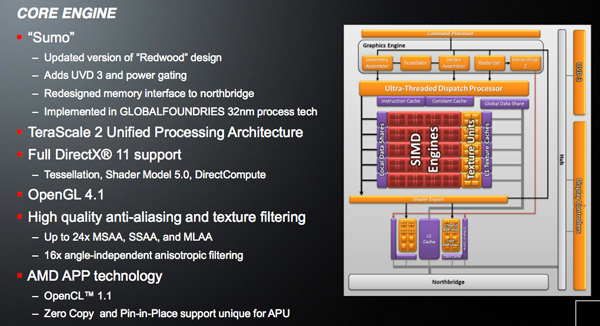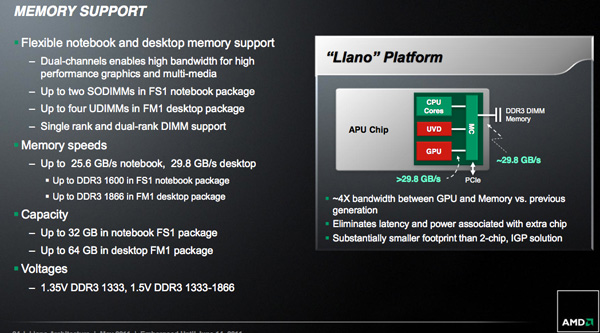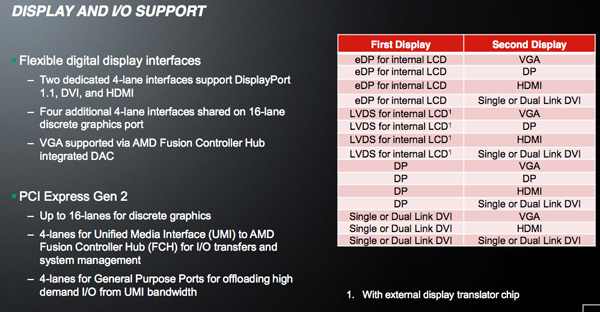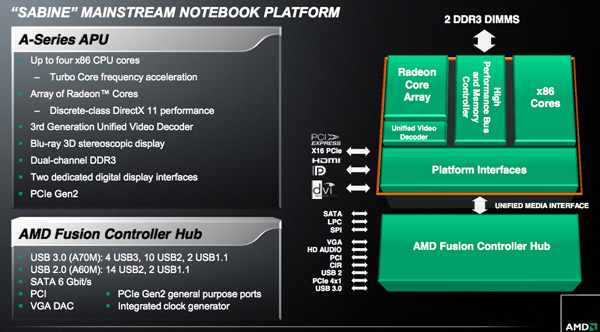The AMD Llano Notebook Review: Competing in the Mobile Market
by Jarred Walton & Anand Lal Shimpi on June 14, 2011 12:01 AM ESTThe GPU
While the Llano CPU cores may be in need of a major overhaul, Llano's GPU is as new as it gets. Technically based off of AMD's Redwood core (Radeon HD 5570) with some enhancements, Llano's GPU is codenamed Sumo.
The DX11 GPU features five SIMD arrays, each with 80 cores for a total of 400 shader processors. Similar to the updates we saw with this year's Northern Islands GPUs, Sumo does add UVD3 support to the Redwood architecture. Of course since Sumo shares the same die as the Llano CPU cores it is built on GlobalFoundries' 32nm process, making this the first AMD GPU fabbed at GlobalFoundries and not TSMC.
For everything behind the memory controller Sumo is virtually identical to Redwood. Where Sumo differs is in its memory interface. Although Llano is AMD's first performance oriented APU, it's still constrained by a 128-bit wide DDR3 memory interface. That dual-channel memory interface has to be shared by all four Llano cores as well as the Sumo GPU and as a result, arbitration is very important.
AMD shared a few choice details about the Llano memory controller architecture. To begin, AMD guarantees more than 30GB/s of bandwidth is available between the GPU and the memory controller—in other words, the path from GPU to the memory controller won't become a bottleneck. The GPU/memory controller link (i.e. within the APU die) can apparently scale up to as much as 50GB/s to support future APUs with even faster memory interfaces. Note that unlike previous integrated graphics solutions, there is no support for dedicated external memory—this is a pure shared memory architecture.
Second, and most importantly, AMD can dynamically prioritize memory bandwidth between the CPU and GPU. In most cases, when both processors are heavily consuming data, the GPU is given priority over the CPU. Given today's workloads, prioritizing the GPU for memory accesses makes sense when it's running full tilt. The chances of you stressing all four CPU cores and running at full GPU memory bandwidth requirements are pretty slim today.
With 400 shader processors behind a shared 128-bit DDR3 memory interface, the upper bound for Sumo performance is the Radeon HD 5570. In practice, you should expect performance to be noticeably lower since the GPU does have to share its precious memory bandwidth with up to four x86 CPU cores.
The mobile version of Llano supports up to DDR3-1600 while the desktop parts can run at up to DDR3-1866. Maximum memory capacities are 32GB and 64GB for notebooks and desktops, respectively.
Llano has a total of 24 PCIe Gen 2 lanes at its disposal. Sixteen of those lanes can be used for external graphics. Four of the lanes can be used for devices that need low latency/high bandwidth access to the APU itself (e.g. Gigabit ethernet). The remaining four lanes are used to connect the APU to its sole partner in crime: the Fusion Controller Hub.
AMD is particularly proud of the display output configurations supported by Llano. The possible combinations are listed below:
Chipsets
AMD will offer two Fusion Controller Hubs (FCHs) as options for Llano: A70M and A60M. The only difference between the two is in their support for USB 3.0; the A70M has four USB 3.0 ports while the A60M has none.
Both FCHs support 6Gbps SATA and perform just as well as AMD's 8-series chipset (or Intel's Z68) with a high performance SSD. USB 3.0 performance is also comparable to 3rd party solutions we've seen deployed on motherboards already.















177 Comments
View All Comments
Brian23 - Tuesday, June 14, 2011 - link
Jarred/Anand,Based on the benchmarks you've posted, It's not very clear to me how this CPU performs in "real world" CPU usage. Perhaps you have it covered with one of your synthetic benchmarks, but by looking at the names, it's not clear which ones stress the integer vs floating point portions of the processor.
IMO, a test I'd REALLY like to see is how this APU compares in a compile benchmark against a C2D 8400 and a i3 380M. Those are both common CPUs that can be used to compare against other benchmarks.
Could you compile something like Chrome or Firefox on this system and a couple others and update the review?
Thanks! I appreciate the work you guys do!
ET - Tuesday, June 14, 2011 - link
PCMark tests common applications. You can read more details here: http://www.pcmark.com/wp-content/uploads/2011/05/P...While I would find a compilation benchmark interesting, are you suggesting that this will be more "real world"? How many people would do that compared to browsing, video, gaming? Probably not a lot.
Brian23 - Tuesday, June 14, 2011 - link
Thanks for the link. I was looking for something that described what the synthetic benchmarks mean.As for "real world," it really depends from one user to the next. What I was really trying to say is that no-one buys a PC just to run benchmarks. Obviously the benchmark companies try to make their benchmarks simulate real world scenarios, but there's no way they can truly simulate a given person's exact workload because it's going to be different from someone else's workload.
If we're going down the synthetic benchmark path, what I'd like to see is a set of benchmarks that specifically stresses one aspect of a system. (i.e. integer unit or FPU.) That way you can compare processor differences directly without worrying about how other aspects of the system affect what you're looking at. In the case of this review, I was looking at the Computation benchmark listed. After reading the whitepaper, I found out that benchmark is stressing both the CPU and the GPU, so it's not really telling me just about the CPU which is the part I'm interested in.
Switching gears to actual real world tests, seeing a compile will tell me what I'm interested in: CPU performance. Like you said, most people aren't going to be doing this, but it's interesting because it will truly test just the CPU.
JarredWalton - Tuesday, June 14, 2011 - link
Hi Brian,I haven't looked into compiling code in a while, but can you give me a quick link to a recommended (free) Windows compiler for Chrome? I can then run that on all the laptops and add it to my benchmark list. I would venture to say that an SSD will prove more important than the CPU on compiling, though.
Brian23 - Tuesday, June 14, 2011 - link
Jarred,This link is a user's quick how-to for compiling chrome:
http://cotsog.wordpress.com/2009/11/08/how-to-comp...
This is the official chrome build instructions:
http://dev.chromium.org/developers/how-tos/build-i...
Both use Visual Studio Express which is free.
I really appreciate this extra work. :-)
krumme - Tuesday, June 14, 2011 - link
The first links at the top is sponsored3 times exactly the same i7 + 460 ! ROFL
Then 1 i7 with a 540
Damn - looks funny, but at least it not 1024 *768 like the preview, but the most relevant resolution for the market - thank you for that
Shadowmaster625 - Tuesday, June 14, 2011 - link
Man what is it with this dumb yuppie nonsense. No I dont want to save $200 because I dont actually work for my money. Hell, if you're even reading this site then it is highly likely that the two places you want more performance from your notebook is games and internet battery life. All this preening about intel's crippled cpu being 50% faster dont mean jack because ... well its a crippled cpu. It cant play games yet it has a stupid igp. Why get all yuppity about such an obvious design failure, so much so that you'd be willing to sneeze at a $200 savings like it means nothing. It actually means something to people who work for a living. Most people just dont need the extra 50% cpu speed from a notebook. But having a game that runs actually does mean something tangible.madseven7 - Tuesday, June 14, 2011 - link
I'm not sure why people think this is such a crappy cpu. Am I missing something? Wasn't the Llano APU that was tested the lowest of the A8 series with DDR 1333? Doesn't it give up 500MHz-800MHz to the SB notebooks that were tested? Wouldn't the A8 3530mx perform much better? I for one would love to see a review of the A8 3530mx personally.ET - Tuesday, June 14, 2011 - link
Good comment. This is the highest end 35W CPU, but not the highest end Llano. So it gets commended for battery life but not performance. It will be interesting to see the A8-3530MX results for performance and battery life. It would still lose to Sandy Bridge quite soundly on many tests, I'm sure, but it's still a significant difference in clock speed over the A8-3500M..Jasker - Tuesday, June 14, 2011 - link
One thing that is really interesting that isn't brought up here is the amount of power used during gaming. Not only do you get much better gaming than Intel, but you also get much less power. Double whammy.